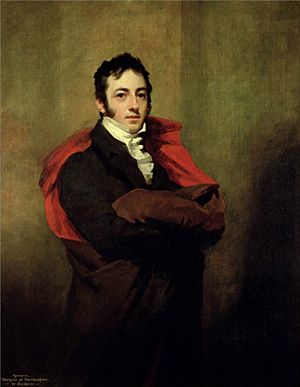Spencer Compton, 2nd Marquess of Northampton facts for kids
Quick facts for kids
The Most Honourable
The Marquess of Northampton
|
|
|---|---|

A painting of the Marquess of Northampton made by Henry Raeburn in 1821.
|
|
| 26th President of the Royal Society | |
| In office 1830–1838 |
|
| Preceded by | Prince Augustus Frederick |
| Succeeded by | William Parsons |
| Member of Parliament for Northampton |
|
| In office 1812–1820 |
|
| Preceded by | Spencer Perceval |
| Succeeded by | George Robinson |
| Personal details | |
| Born | 2 January 1790 |
| Died | 17 January 1851 (aged 61) |
| Resting place | Castle Ashby |
| Nationality | British |
| Spouse | Margaret Clephane |
| Alma mater | Trinity College, Cambridge |
Spencer Joshua Alwyne Compton (born January 2, 1790 – died January 17, 1851) was an important British nobleman. He was also known as Lord Compton and Earl Compton during different parts of his life. He loved and supported both science and the arts.
Contents
Early Life and Politics
Spencer Compton was the second son of the 9th Earl of Northampton. He went to Trinity College, Cambridge, a famous university. He earned a Master of Arts degree there in 1810.
In 1812, Spencer became Earl Compton. He then became a Member of Parliament for Northampton. This meant he had a seat in the House of Commons. The House of Commons is a part of the British Parliament.
On July 24, 1815, he married Margaret Maclean Clephane. She was the eldest daughter of Major-general Douglas Maclean Clephane.
In Parliament, Spencer Compton was known for being a bit different. His family usually supported the Tory political party. However, he often voted against the Tory government. Because of this, he lost his seat in Parliament in 1820.
Life in Italy and Return to England
After 1820, Spencer Compton moved to Italy. His home there became a popular meeting place. He used his influence to help people who were being treated unfairly. This included people in Lombardy and Naples.
He returned to England in 1830. Back home, he became a key figure in politics and culture. He supported the Reform Bill in the House of Lords. This bill aimed to make the voting system fairer. However, he became even more involved in promoting arts and sciences.
Supporting Science and Arts
Spencer Compton was a leader in several important groups. From 1820 to 1822, he was president of the Geological Society of London. He also led the Archaeological Institute of Great Britain and Ireland twice.
In 1838, he became president of the Royal Society. This is a very old and famous scientific group. He held this position for ten years. He was especially interested in geology, which is the study of Earth's rocks and history. He loved fossils even though he was not a scientist himself. He was more of an interested amateur. A dinosaur species, Regnosaurus northamptoni, was named after him.
He left the Royal Society in 1848. This was because he disagreed with the Society becoming more professional. In 1846, he was made an honorary member of the American Academy of Arts and Sciences. From 1849 until his death, he was president of the Royal Society of Literature.
Spencer Compton passed away on January 17, 1851. He was buried at Castle Ashby on January 25.
Family Life
On July 24, 1815, Spencer Compton married Margaret Douglas-Maclean-Clephane. Margaret was a poet. Famous writers like Sir Walter Scott and William Wordsworth admired her poems. However, her poetry was never published.
Their marriage was a happy one. They had six children together. The family lived in Italy for ten years, from 1820 to 1830. In 1828, Spencer became the Marquess of Northampton after his father passed away. After his wife, Lady Northampton, died in 1830, he returned to England.
Their children included:
- Charles Compton, 3rd Marquess of Northampton (1816–1877)
- Lady Marianne Margaret Compton (1817–1888), later known as Lady Marian Alford
- Admiral William Compton, 4th Marquess of Northampton (1818–1897)
- Lord Alwyne Compton (1825–1906), who became a bishop
- Lady Margaret Compton, who married Frederick Leveson-Gower
Images for kids
See also


